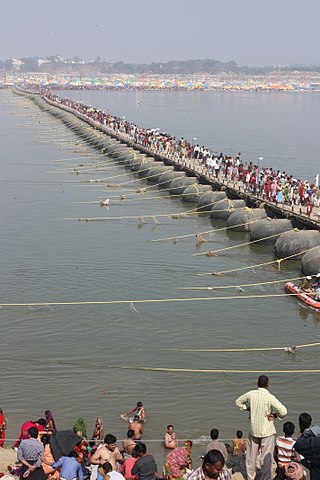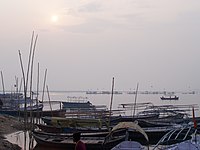
The Yamuna is the second-largest tributary river of the Ganges by discharge and the longest tributary in India. Originating from the Yamunotri Glacier at a height of about 4,500 m (14,800 ft) on the southwestern slopes of Bandarpunch peaks of the Lower Himalaya in Uttarakhand, it travels 1,376 kilometres (855 mi) and has a drainage system of 366,223 square kilometres (141,399 sq mi), 40.2% of the entire Ganges Basin. It merges with the Ganges at Triveni Sangam, Prayagraj, which is a site of the Kumbh Mela, a Hindu festival held every 12 years.

Kumbh Mela or Kumbha Mela is a major pilgrimage and festival in Hinduism, On February 4, 2019, Kumbh Mela witnessed the largest public gathering. It is celebrated in a cycle of approximately 12 years, to celebrate every revolution Brihaspati (Jupiter) completes, at four river-bank pilgrimage sites: Prayagraj, Haridwar (Ganges), Nashik (Godavari), and Ujjain (Shipra). The festival is marked by a ritual dip in the waters, but it is also a celebration of community commerce with numerous fairs, education, religious discourses by saints, mass gatherings of monks, and entertainment. The seekers believe that bathing in these rivers is a means to prāyaścitta for past mistakes, and that it cleanses them of their sins.
Prayag is a historical name of the area near the confluence of the Ganges and Yamuna rivers in the modern-day city of Prayagraj in northern India.

Prayagraj district, also known as Allahabad district, is the most populous district in the Indian state of Uttar Pradesh. Prayagraj city is the district headquarters of this district. The District is divided into blocks within tehsils. As of 2011, there are 20 blocks in eight tehsils. The Prayagraj division includes the districts of Pratapgarh, Fatehpur, Kaushambi and Prayagraj, with some western parts that had previously part of Allahabad District becoming part of the new Kaushambi District. The administrative divisions are Phulpur, Koraon, Meja, Sadar, Soraon, Handia, Bara, Shringverpur and Karchana.

Allahabad Fort was built by the Mughal emperor Akbar at Prayagraj in 1583. The fort stands on the banks of the Yamuna, near its confluence with the Ganges. It is classified by the Archaeological Survey of India as a monument of national importance.

Tirumakudalu Narasipura the temple city of Karnataka, commonly known as T. Narasipura or T.N. Pura, is a town in Mysore district in the Indian state of Karnataka. The first name refers to the land at the confluence, (trimakuta in Sanskrit at the confluence of the Kaveri, Kabini and Spatika Sarovara.
Alopibagh is a locality/township of Prayagraj, Uttar Pradesh, India. The locality is close to the Kumbh Mela area, the Sangam, the rivers Ganges and Yamuna, and one of the most ancient Hindu temples of India, the Alopi Devi Mandir, is also in this locality. Alopibagh is adjacent to Daraganj, the oldest suburb of Prayagraj and the most important bathing Ghat on the bank of Ganges.
Govindpur is one of the oldest colonies established by Prayagraj Development Authority in 1981 at the bank of the river Ganges.

Prayagraj, also known as Ilahabad or Allahabad in an anglicized version in Roman script, and anciently Prayag, is a city situated on an inland peninsula, surrounded by the rivers Ganges and Yamuna on three sides, with only one side connected to the mainland Doab region, of which it is a part. This position is of importance in Hindu scriptures for it is situated at the confluence, known as Triveni Sangam, of the holy rivers. As per Rigveda the Sarasvati River was part of the three river confluence in ancient times. It is one of four sites of the Kumbh Mela, an important mass Hindu pilgrimage.

Prayagraj, also known as Allahabad or Illahabad, is a metropolis in the Indian state of Uttar Pradesh. It is the administrative headquarters of the Prayagraj district, the most populous district in the state and 13th most populous district in India and the Prayagraj division. The city is the judicial capital of Uttar Pradesh with the Allahabad High Court being the highest judicial body in the state. As of 2011, Prayagraj is the seventh most populous city in the state, thirteenth in Northern India and thirty-sixth in India, with an estimated population of 1.53 million in the city. In 2011, it was ranked the world's 40th fastest-growing city. The city, in 2016, was also ranked the third most liveable urban agglomeration in the state and sixteenth in the country. Hindi is the most widely spoken language in the city.

Tribeni is a locality in Bansberia Municipality of Hooghly district in the Indian state of West Bengal and is currently a part of the area covered by (KMDA). It is an old holy place for the Hindus, the sanctity of which has been recognized for many centuries and had been mentioned in Pavanaduta, a Sanskrit piece of the last quarter of the 12th century. The Muslims took it over during early phases of their conquest of Bengal, also referred to as Turkish conquest in the thirteenth century. The place retains its holiness for multiple centuries, primarily due to the rivers it hosted, corroborated by records of the bathers at different timelines, who thronged during the festival of Makar Sankranti. Of the many odes written on the Ganges in various Indian languages.
Daraganj is a prominent suburb and a landmark in the city of Prayagraj. It is the oldest suburb of Prayag at the bank of celestial river Ganges and not far from Triveni Sangam - the confluence of three sacred rivers: the Ganges and Yamuna, and the third invisible river Saraswati. Thus, Daraganj is essentially a theoretical and philosophical reference point of city now called Prayagraj.
Uttarakhand is a state in the northern part of India. It is often referred to as the "Devbhumi" due to its religious significance and numerous Hindu temples and pilgrimage sites found throughout the state. As a result, religious tourism forms a major portion of the tourism in the state. Uttarakhand is known for the natural environment of the Himalayas. 2019 Tourist Arrivals Domestic – 40,000,000 per/year and Foreigner – 150,000 per year. Tourism business in Uttarakhand generated ₹ 23,000 crores during 2013–14.

The Prayag Kumbh Mela, also known as Allahabad Kumbh Mela is a mela, or religious gathering, associated with Hinduism and held in the city of Prayagraj, India, at the Triveni Sangam, the confluence of the Ganges, the Yamuna, and the mythical Sarasvati river. The festival is marked by a ritual dip in the waters, but it is also a celebration of community commerce with numerous fairs, education, religious discourses by saints, mass feedings of monks or the poor, and entertainment spectacle. Approximately 50 and 30 million people attended the Allahabad Ardh Kumbh Mela in 2019 and Maha Kumbh Mela in 2013 respectively to bathe in the holy river Ganges, making them the largest peaceful gathering events in the world.

Prayag Junction railway station is an important railway station in Prayagraj district, Uttar Pradesh. It serves Prayag town in Prayagraj. It consists of three platforms. The NR is developing the neighbouring Prayagraj sangam station as a coaching terminal. It is designed by architect M K Singh in the year 2018. There will be five new platforms, two washing lines, and a new station building with basement.
Triveni Express is an Express train belonging to North Eastern Railway zone that runs between Shaktinagar Terminal and Tanakpur in India. It is currently being operated with 15075/15076 train numbers on four days in week basis.
Kaveri is a tributary of the Narmada River in Madhya Pradesh, India. It has a length of 40 km, and a catchment area of 954 km².

The 2019 Prayagraj Ardh Kumbh Mela was the Ardh Kumbh Mela held at Triveni Sangam in Prayagraj, Uttar Pradesh, India from 15 January to 4 March 2019.
Saraswati Ghat is probably the most spectacular ghat in Prayagraj on the bank of Yamuna river in the Indian state of Uttar Pradesh. It is located close to Mankameshwar Temple of lord Shiva. The name of ghat comes from Hindu Goddess of learning Saraswati. It is a newly built place. Stairs from three sides descend to the greenish water of the Yamuna. Above there is a park which is covered with green grass.











